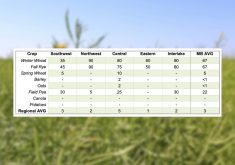We’re not going to do anything that’s illicit. But I think research has to go on.”
– RANDALL WESELAKE
AUniversity of Alberta researcher has bowed to pressure from the flax industry and cancelled plans to conduct plot trials on a genetically modified flax this spring.
Randall Weselake, the University of Alberta professor developing the new GM flax, decided not to proceed with the trials, which had been approved by the Canadian Food Inspection Agency, after the Saskatchewan Flax Development Commission (SFDC) and the Flax Council of Canada (FCC) wrote to him expressing their concerns.
Read Also

Manitoba sclerotinia picture mixed for 2025
Variations in weather and crop development in this year’s Manitoba canola fields make blanket sclerotinia outlooks hard to pin down
FCC chair Terry James made it clear “he wasn’t too happy with us,” and wrote that he didn’t think anybody should have field plots of a GM flax given the Triffid situation, Weselake said in an interview.
“We’re not out to mess things up,” Weselake said. “We want to provide benefits to mankind.”
Canada’s flax industry, still struggling from the fallout over CDC Triffid contamination, is relieved.
The industry trying to remove Triffid – a GM flax approved here but not by the European Union (EU), Canada’s biggest market – from the pipeline.
Outdoor plots of a new GM flax wouldn’t look good to EU buyers as Canada tries to restore its reputation, said Linda Braun, executive director of the SFDC said in an interview May 6.
“It’s partly the optics but it’s also the science on the whole contamination and contamination of breeder seed,” she said. “We don’t know exactly how that happened. Without having found answers to those questions we’re very concerned about introducing more of it (GM flax) into our environment.”
TRACES
The EU found traces of CDC Triffid in Canadian flax exports last summer, triggering recalled flax products, lost markets and lawsuits. Canada is shut out of the lucrative EU food flax market. Meanwhile, Canadian exporters are reluctant to pursue sales in the industrial flax market for fear their cargoes could also be rejected.
Weselake said he wanted to grow a plot of the new GM flax to get enough seed to crush and test the oil’s performance when fed to fish and livestock.
Weselake is developing GM flax oil that when consumed by humans or animals will enhance their ability to make eicosapentaenoic acid (EPA) and docosahexaenoic acid (DHA) – two omega-3 fatty acids known for contributing to cardiovascular health and bolstering the immune system.
“We’re generating a health oil,” Weselake said. “I think this is something consumers would like. It’s certainly being pursued by many companies around the world (including laboratories in Germany the United Kingdom and the United States).”
If Canada stops its research it will fall behind its competitors, he said.
CFIA has a long list of rules developers must follow when they are granted “confined field trial” approval for a GM crop. They include measures to prevent the experimental crops from escaping into the environment such as isolation from non-GM crops, pollen traps, deep tilling after the crop has been removed and future monitoring.
SAFEGUARDS UNDER SCRUTINY
Nevertheless, CFIA’s safeguards are also under scrutiny because of what happened with Triffid.
The biggest potential demand for this new GM flax will be fish farms, Weselake said. Farmed fish don’t produce the same level of omega-3 fatty acids as wild fish, which get most of their supply by consuming algae, he said. Now farmed fish are fed other fish to boost their omega-3 content, but the supply of wild fish oil is growing short.
Weselake said it would be years before the flax would be commercialized. “We’re not going to do anything that’s illicit. But I think research has to go on.”
To that end, Weselake said he’s considering seeding plots in South America. There’s a lot of interest in fish farming and feeding omega-3 enhanced flax oil in Chile and Argentina, he said.
Weselake said he will soon meet with the SFDC and FCC to explain his research and hear the industry’s concerns.
Much of the funding for this new GM flax comes from a venture capital fund. The plan is to patent the GM trait, Weselake said. If approved in Canada for commercial release, the flax would be grown under contract and identity preserved to maintain the integrity of the oil.
APPROVAL NEEDED
While the SFDC supports crop innovations, its policy is to only support the commercialization of GM flax if it’s approved in Canada, as well as in current and emerging export markets, there’s a system to preserve its identity, a fast test to identify the GM trait and there are “positive benefits and financial returns” for Saskatchewan flax growers.
The Mani toba Flax Growers Association doesn’t want any GM flax grown commercially until it has market acceptance, said president Eric Fridfinnson.
Care should also be taken to prevent any new GM flax from getting into the environment before it’s approved, he added.



















